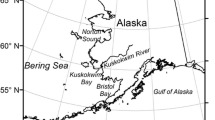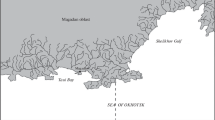Abstract
Since salmon species commonly undertake long spawning migrations and often have multiple runs in the same river system, this study explored the run timing and physiology of sympatric Chinook salmon Oncorhynchus tshawytscha stocks in the Klamath River Basin, CA. Genetic methods revealed that the Trinity-Salmon Spring run entered first, followed by the Klamath Fall run, and the Lower Basin Fall run. The Trinity-Salmon Fall run entered continuously. There was however, considerable overlap in run timing which was thought may be due a morphological threshold being met. Due to longer off-feeding freshwater residency, the earlier-returning fish have higher metabolic demands during their spawning migration and enter freshwater with greater relative fat reserves, estimated by non-water fraction of liver tissue (NWF) and Relative Weight (Wr). They also arrive less mature (as estimated by gonadosomatic index (GSI), which also places a greater demand on their energy reserves for gonadal development. There was a decrease in relative fat reserves and an increase in maturity by freshwater entry date. At spawning however, the Trinity River Hatchery spring- and fall-run fish, after travelling the same distance, had the same relative fat content and size-specific gonad mass and fecundity. The higher energetic cost associated with the early entry of the spring-run fish, and reduced at-sea feeding period, may be the cause for their smaller average body mass. This study suggests that imminent freshwater residency duration is important in determining the relative fat content, maturity leveland size of returning Chinook salmon.





Similar content being viewed by others
References
Adams CE, Huntingford FA (1997) Growth, maturation and reproductive investment in artic charr. J Fish Biol 51:750–759. doi:10.1111/j.1095-8649.1997.tb01996.x
Anderson EC, Waples RS, Kalinowski ST (2008) An improved method for predicting the accuracy of genetic stock identification. Can J Fish Aquat Sci 65:1475–1486. doi:10.1139/F08-049
Beacham TD, Murray CB (1993) Fecundity and egg size variation in North American pacific Salmon. J Fish Biol 42:485–508. doi:10.1111/j.1095-8649.1993.tb00354.x
Brett JR (1995) Physiological ecology of pacific salmon. University of British Columbia Press, Vancouver, pp 3–68
Cederholm CJ, Kunze MD, Murota T, Sibatani A (1999) Pacific salmon carcasses, essential contributions of nutrients and energy for aquatic and terrestrial ecosystems. Fisheries 24:6–15
Chesney D (2009) Klamath River project recovery of fall-run Chinook and Coho salmon at Iron Gate Hatchery 2008. California Department of Fish and Game, Yreka
Crossin GT, Hinch SG, Farrell AP, Higgs DA, Lotto AG, Oakes JD, Healey MC (2004) Energetics and morphology of sockeye salmon, effects of upriver migratory distance and elevation. J Fish Biol 65:788–810. doi:10.1111/j.0022-1112.2004.00486.x
Development Core Team R (2010) R, a language and environment for statistical computing. R Foundation for Statistical Computing, Vienna, Austria
Drake DC, Smith JV, Naiman RJ (2005) Salmon decay and nutrient contributions to riparian forest soils. Northwest Sci 79:61–71
English KK, Koski WR, Sliwinski C, Blakley A, Cass A, Woody JC (2006) Migration timing and river survival of late-run Fraser River Sockeye salmon estimated using radiotelemetry techniques. Trans Am Fish Soc 134:1342–1365. doi:10.1577/T04-119.1
Fisher JP, Pearcy WG (1990) Distribution and residence times of juvenile fall and spring chinook salmon in Coos Bay, Oregon. Fish Bull 88:51–58
Fleming IA, Gross MR (1990) Latitudinal clines: a trade-off between egg number and size in Pacific salmon. Ecology 71:1–11. doi:10.2307/1940241
Fleming IA, Gross MR (1993) Breeding success of hatchery and wild Coho salmon (Oncorhynchus kisutch) in competition. Ecol Appl 3:230–245
Fleming IA, Gross MR (1994) Breeding competition in a Pacific salmon (Coho, Oncorhynchus Kisutch), measures of natural and sexual selection. Evolution 48:637–657
Friedland KD, Ama-Abasi D, Manning M, Clarke L, Kligys G, Chambers RC (2005) Automated egg counting and sizing from scanned images, rapid sample processing and large data volumes for fecundity estimates. Jo Sea Res 54:307–316
Gall GD, Bartley D, Bentley B, Brodziak J, Gomulkiewicz R, Mangel M (1992) Geographic variation in population genetic structure of Chinook salmon from California and Oregon. Fish Bull 90:77–100
Gharrett AJ, Shirley SM, Tromble GR (1987) Genetic relationship among populations of Alaskan Chinook salmon (Oncorhynchus tshawytscha). Can J Fish Aquat Sci 44:765–774. doi:10.1139/f87-093
Hankin DG, Logan E (2010) A preliminary analysis of Chinook salmon coded-wire tag recovery data from Iron Gate, Trinity River and Cole Rivers Hatcheries, brood years 1978-2004. Report prepared under contract for The Hoopa Valley Tribal Council and the U.S. Fish and Wildlife Service, Arcata, CA 95521
Hartman KJ, Margraf FJ (2008) Common relationships among proximate composition components in fishes. J Fish Biol 73:2352–2360. doi:10.1111/j.1095-8649.2008.02083.x
Healey MC (2001) Patterns of gametic investment by female stream- and ocean-type Chinook salmon. J Fish Biol 58:1545–1556. doi:10.1111/j.1095-8649.2001.tb02311.x
Heath DD, Heath JW, Bryden CA, Johnson RM, Fox CW (2003) Rapid evolution of egg size in captive salmon. Science 299:1738–1740. doi:10.1126/science.1079707
Helfield JM, Naiman RJ (2001) Effects of salmon-derived nitrogen on riparian forest growth and implications for stream productivity. Ecology 82:2403–2409
Hendry AP, Berg OK (1999) Secondary sexual characters, energy use, senescence, and the cost of reproduction in sockeye salmon. Can J Zool 77:1663–1675. doi:10.1139/z99-158
Hendry AP, Day T (2005) Population structure attributable to reproductive time, isolation by time and adaptation by time. Mol Ecol 14:901–916. doi:10.1111/j.1365-294X.2005.02480.x
Hilborn R, Walters CJ, Ludwig D (1995) Sustainable exploitation of renewable resources. Annu Rev Ecol Syst 26:45–76
Jezierska BJ, Hazel R, Gerking SD (1982) Lipid mobilization during starvation in the rainbow trout, Salmo gairdneri Richardson, with attention to fatty acids. J Fish Biol 21:681–692. doi:10.1111/j.1095-8649.1982.tb02872.x
Kalinowski ST (2004) Genetic polymorphism and mixed-stock fisheries analysis. Can J Fish Aqua Sci 61:1075–1082. doi:10.1139/F04-060
Kalinowski ST, Manlove KR, Taper ML (2008) ONCOR, A computer program for genetic stock identification. Distributed by the author, Montana State University, Bozeman
King HR, Pankhurst NW (2003) Ovarian growth and plasma sex steroid and vitellogenin profiles during vitellogenesis in Tasmanian female Atlantic salmon (Salmo salar). Aquaculture 219:797–813. doi:10.1016/S0044-8486(02)00647-6
Kinnison MT, Unwin MJ, Hendry AP, Quinn TP (2001) Migratory costs and the evolution of egg size and number in introduced and indigenous salmon populations. Evolution 55:1656–1667. doi:10.1111/j.0014-3820.2001.tb00685.x
Kinnison MT, Unwin MJ, Quinn TP (2003) Migratory costs and contemporary evolution of reproductive allocation in male chinook salmon. J Evol Biol 16:1257–1269. doi:10.1046/j.1420-9101.2003.00631.x
Kinziger AP, Hellmair M, Hankin DG (2008a) Genetic structure of Chinook salmon (Oncorhynchus tshawytscha) in the Klamath-Trinity basin, implications for within-basin genetic stock identification. Report of Humboldt State University Sponsored Programs Foundation to Hoopa Valley Tribal Fisheries Department. Contract title, GSI Kalmath Chinook. Project number, 1.22–4275, in press
Kinziger AP, Loudenslager EJ, Hankin DG, Anderson, Garza JC (2008b) Hybridization between spring- and fall-run Chinook salmon returning to the Trinity River. California N Am J Fish Manage 28:1426–1438. doi:10.1577/M07-103.1
Mesa MG, Magie CD (2006) Evaluation of energy expenditure in adult spring Chinook salmon migrating upstream in the Columbia River Basin, an assessment based on sequential proximate analysis. River Res Appl 22:1085–1095. doi:10.1002/rra.955
Missildine BR, Peters RJ, Chin-Leo G, Houck D (2005) Polychlorinated biphenyl concentrations in adult Chinook salmon (Oncorhynchus tshawytscha) returning to coastal and Puget Sound hatcheries of Washington State. Environ Sci Technol 39:6944–6951. doi:10.1021/es0506408
Moffett JR, Smith SH (1950) Biological investigations of the fishery resources of Trinity River, California. U.S. Fish & Wildlife Service Special Scientific Report, Fisheries 12
Montgomery DR, Buffington JM, Peterson NP, Schuett-Hames D, Quinn TP (1996) Stream-bed scour, egg burial depths, and the influence of salmonid spawning on bed surface mobility and embryo survival. Can J Fish Aquat Sci 53:1061–1070. doi:10.1139/f96-028
Quinn TP, Foote CJ (1994) The effects of body size and sexual dimorphism on the reproductive behaviour of sockeye salmon, Oncorhynchus nerka. Anim Behav 48:751–761. doi:10.1006/anbe.1994.1300
Quinn TP, Unwin MJ, Kinnison MT (2000) Evolution of temporal isolation in the wild, genetic divergence in timing of migration and breeding by introduced chinook salmon populations. Evolution 54:1372–1385. doi:10.1111/j.0014-3820.2000.tb00569.x
Rand PS, Hinch SG (1998) Swim speeds and energy use of upriver migrating sockeye salmon (Oncorhynchus nerka): simulating metabolic power and assessing risk of energy depletion. Can J Fish Aquat Sci 55:1832–1841. doi:10.1139/f98-068
Richey J (2006) Klamath River Project recovery of fall-run Chinook and Coho salmon at Iron Gate Hatchery 2005. California Department of Fish and Game, Yreka
Rosenberg A, Fogarty MJ, Sissenwine MP, Beddington JR, Shepherd JG (1993) Achieving sustainable use of renewable resources. Science 262:828–829
Rowe DK, Thorpe JE, Shanks AM (1991) The role of fat stores in the maturation of male Atlantic salmon (Salmo salar) parr. Can J Fish Aquat Sci 48:405–413. doi:10.1139/f91-052
Silverstein JT, Shimma H, Ogata H (1997) Early maturity in amago salmon (Oncorhynchus masu ishikawai): an association with energy storage. Can J Fish Aquat Sci 54:444–451. doi:10.1139/f96-284
Sinnen W, Currier M, Knechtle M, Borok S (2004–2006) Annual Report, Trinity River basin salmon and steelhead monitoring project, 2002–2003, 2003–2004, 2004–2005seasons. California Department of Fish and Game, Arcata
Smoker WW, Gharrett AJ, Stekoll MS (1998) Genetic variation of return date in a population of Pink salmon, a consequence of fluctuating environment or dispersive selection? Alaska Fish Res Bull 5:46–54
Snyder JO (1931) Salmon of the Klamath River, California. California Department of Fish & Game Fish Bulletin 34, Sacramento
Steen RP, Quinn TP (1999) Egg burial depth by sockeye salmon (Oncorhynchus nerka), implications for survival of embryos and natural selection on female body size. Can J Zool 77:836–841. doi:10.1139/z99-020
Stewart DC, Smith GW, Youngson AF (2002) Tributary-specific variation in timing of return of adult Atlantic salmon (Salmo salar) to fresh water has a genetic component. Can J Fish Aquat Sci 59:276–281. doi:10.1139/f02-011
Unwin MJ, Poortenaar CW, Rowe DK, Boustaed NC, Porter R (2004) Seasonal profiles in growth, energy reserves, gonad development, and plasma steroids in age 1+ cultured Chinook salmon (Oncorhynchus tshawytscha) females. NZ J Mar Freshwat Res 38:29–41. doi:10.1080/00288330.2004.9517215
Waples RS, Teel DJ, Myers JM, Marshall AR (2004) Life-history divergence in Chinook salmon, historic contingency and parallel evolution. Evolution 58:386–403. doi:10.1111/j.0014-3820.2004.tb01654.x
Wege, G. J. and Anderson, R.O. (1978) Relative weight (Wr): a new index of condition for largemouth bass. Pages 79. New Approaches to the Management of Small Impoundments. American Fisheries Society, Special Publication 5. Bethesda, Maryland
Woo NY, Bern SHA, Nishioka RS (1978) Changes in body composition associated with smoltification and premature transfer to seawater in Coho salmon (Oncorhynchus kisutch) and King salmon (O. tschawytscha). J Fish Biol 13:421–428. doi:10.1111/j.1095-8649.1978.tb03450.x
Young JL, Hinch SG, Cooke SJ, Crossin GT, Patterson DA, Farrel AP, Van Der Kraak G, Lotto AG, Lister A, Healey MC, English KK (2006) Physiological and energetic correlates of en route mortality for abnormally early migrating adult sockeye salmon (Oncorhynchus nerka) in the Thompson River, British Columbia. Can J Fish Aquat Sci 63:1067–1077
Acknowledgements
The authors wish to thank The Institutional Animal Care and Use Committee (IACUC) for approving the use of animal subjects in this study (IACUC #08/09. F.74.E, approval date 4/22/09). We thank the Hoopa Valley Tribe (Hoopa, CA) for funding this research, and the Yurok Tribe (Klamath, CA) for access to their native fishery. We thank CA Fish and Game and the Trinity River Hatchery (Lewiston, CA) for samples and data. We also thank R. Records for GIS support; R. Parker, C. Watkins and D. Hernandez for field assistance and M. Hellmair for software and genetics lab help. We are grateful to the anonymous reviewers for editorial suggestions. J. W. Hearsey particularly wishes to thank S. Hearsey and R. Hearsey for their kind and continual support for this and other projects.
Author information
Authors and Affiliations
Corresponding author
Rights and permissions
About this article
Cite this article
Hearsey, J.W., Kinziger, A.P. Diversity in sympatric chinook salmon runs: timing, relative fat content and maturation. Environ Biol Fish 98, 413–423 (2015). https://doi.org/10.1007/s10641-014-0272-5
Received:
Accepted:
Published:
Issue Date:
DOI: https://doi.org/10.1007/s10641-014-0272-5




